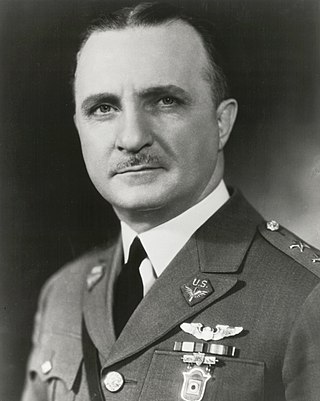
The Royal Flying Corps (RFC) was the air arm of the British Army before and during the First World War until it merged with the Royal Naval Air Service on 1 April 1918 to form the Royal Air Force. During the early part of the war, the RFC supported the British Army by artillery co-operation and photographic reconnaissance. This work gradually led RFC pilots into aerial battles with German pilots and later in the war included the strafing of enemy infantry and emplacements, the bombing of German military airfields and later the strategic bombing of German industrial and transport facilities.
This is a list of aviation-related events from 1934:

This is a list of aviation-related events from 1915:
This is a list of aviation-related events from 1916:
This is a list of aviation-related events from 1917.
This is a list of aviation-related events from 1918:

World War I was the first major conflict involving the large-scale use of aircraft. Tethered observation balloons had already been employed in several wars and would be used extensively for artillery spotting. Germany employed Zeppelins for reconnaissance over the North Sea and Baltic and also for strategic bombing raids over Britain and the Eastern Front.

In aeronautics, a balloon is an unpowered aerostat, which remains aloft or floats due to its buoyancy. A balloon may be free, moving with the wind, or tethered to a fixed point. It is distinct from an airship, which is a powered aerostat that can propel itself through the air in a controlled manner.

A parasite aircraft is a component of a composite aircraft which is carried aloft and air launched by a larger carrier aircraft or mother ship to support the primary mission of the carrier. The carrier craft may or may not be able to later recover the parasite during flight.
This is a list of aviation-related events during the 19th century :

Explorer II was a crewed U.S. high-altitude balloon that was launched on November 11, 1935, and reached a record altitude of 22,066 m (72,395 ft). Launched at 8:00 am from the Stratobowl in South Dakota, the helium balloon carried a two-man crew consisting of U. S. Army Air Corps Captains Albert W. Stevens and Orvil A. Anderson inside a sealed, spherical cabin. The crew landed safely near White Lake, South Dakota, at 4:13 pm and both were acclaimed as national heroes. Scientific instruments carried on the gondola returned useful information about the stratosphere. The mission was funded by the membership of the National Geographic Society.

The Deutsche Luftstreitkräfte – known before October 1916 as Die Fliegertruppen des deutschen Kaiserreiches – was the air arm of the Imperial German Army. In English-language sources it is usually referred to as the Imperial German Air Service, although that is not a literal translation of either name. German naval aviators of the Marine-Fliegerabteilung were an integral part of the Imperial German Navy. Both military branches operated aeroplanes, observation balloons and airships.

Oscar M. Westover was a major general and fourth chief of the United States Army Air Corps.

Albert William Stevens was an officer of the United States Army Air Corps, balloonist, and aerial photographer.

The Bulgarian Air Force is one of the three branches of the Military of Bulgaria, the other two being the Bulgarian Navy and Bulgarian land forces. Its mission is to guard and protect the sovereignty of Bulgarian airspace, and jointly with the other branches, to protect territorial integrity. The Bulgarian Air Force is one of the oldest air forces in Europe and the world. In recent times it has been actively taking part in numerous NATO missions and exercises in Europe.

Beginning in 1908 and ending in 1937, the U.S. Army established a program to operate airships. With the exceptions of the Italian-built Roma and the Goodyear RS-1, which were both semi-rigid, all Army airships were non-rigid blimps. These airships were used primarily for search and patrol operations in support of coastal fortifications and border patrol. During the 1920s, the Army operated many more blimps than the U.S. Navy. Blimps were selected by the Army because they were not seen as "threats" on the battlefield by opposing forces, unlike airplanes, due to their passive role in combat.

Osoaviakhim-1 was a record-setting, hydrogen-filled Soviet high-altitude balloon designed to seat a crew of three and perform scientific studies of the Earth's stratosphere. On January 30, 1934, on its maiden flight, which lasted over 7 hours, the balloon reached an altitude of 22,000 metres (72,000 ft). During the descent the balloon lost its buoyancy and plunged into an uncontrolled fall, disintegrating in the lower atmosphere. The three crew members, probably incapacitated by high g-forces in a rapidly rotating gondola, failed to bail out and were killed by the high-speed ground impact.

The Stratobowl is a compact natural depression within the limits of Black Hills National Forest in South Dakota, south-west of Rapid City. In 1934–1935 it housed a stratospheric balloon launch site, initially known as Stratocamp, sponsored by the National Geographic Society and the United States Army Air Corps. In 1956–1959 the site was reused by the U.S Navy Project Strato-Lab.

Thomas Greenhow Williams "Tex" Settle was an officer of the United States Navy who on November 20, 1933, together with Army major Chester L. Fordney, set a world altitude record in the Century of Progress stratospheric balloon. An experienced balloonist, long-time flight instructor, and officer on the airships USS Shenandoah (ZR-1) and USS Los Angeles (ZR-3), Settle won the Litchfield Trophy in 1929 and 1931, the International Gordon Bennett Race in 1932, the Harmon Aeronaut Trophy for 1933, and the Harmon National Trophy for 1932 and 1933. He also set numerous distance and endurance records.















